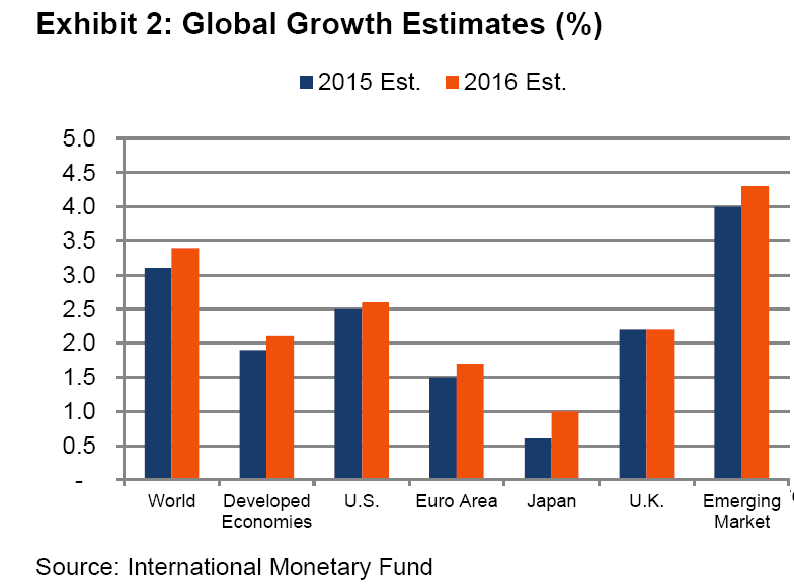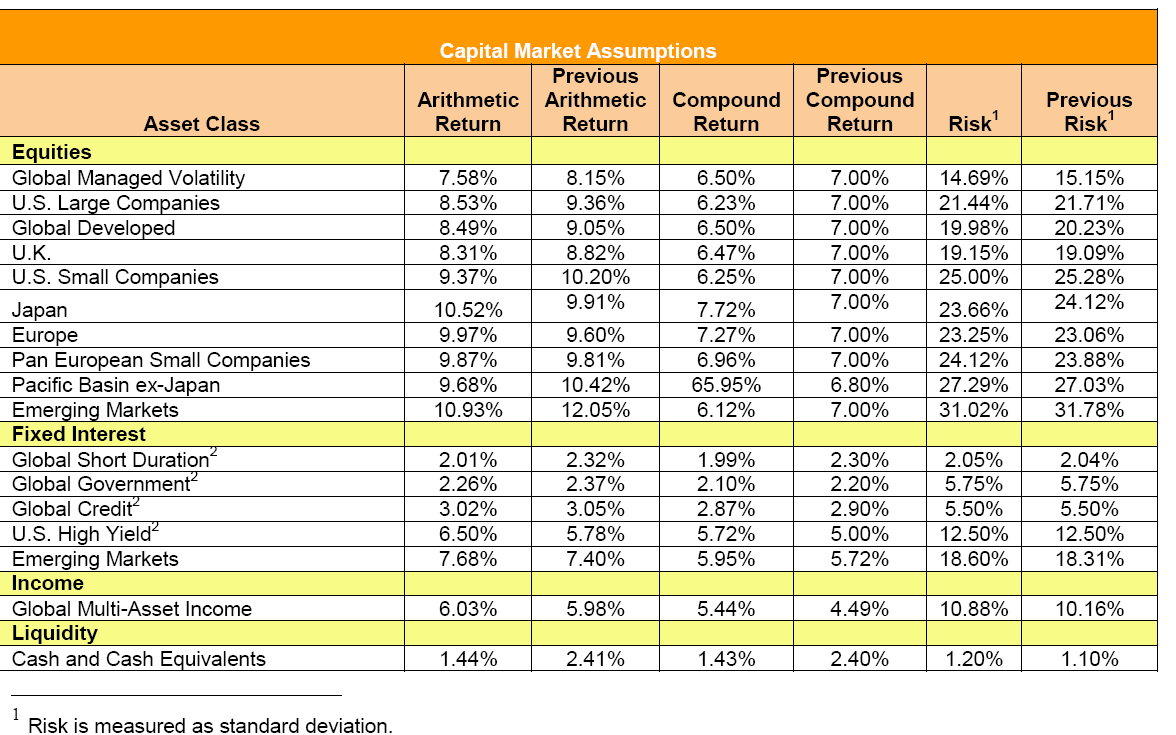Capital Market Assumptions Update: Equities Edge Lower, Fixed Income Mixed
SEI’s Portfolio Strategies Group recently updated its capital market assumptions (CMAs) as part of our review and monitoring process. This update brings risk premiums over cash in line with our current expectations for capital markets.
Fixed-Income Revisions Mixed
Short-term and more-conservative fixed-income strategies witnessed a modest reduction in return expectations, while risk assumptions remained relatively stable. Our reduced return estimates reflect the balancing of our long-term view of equilibrium conditions for bonds versus the current yield environment. Exhibit 1 highlights the differential. More-aggressive strategies (emerging-market debt and high yield) moved incrementally higher, as our modelling accounted for higher correlations with equities and increased risk profiles.

Source: SEI, Bank of England. SEI Equilibrium Curve represents SEI’s expectations.
Across the yield curve, our view is that today’s low interest rates will gradually drift upward — especially for shorter-term bonds — which should result in a flatter yield curve. We therefore expect bond returns over the next 10 years to be lower than historical returns. This reduced return estimate results from both the lower yield on bonds and potential capital losses due to an assumed rise in interest rates.
Global Equity Revised Downward Due to Valuations
Following the aftermath of the 2008 global financial crisis, we lowered our long-term return assumptions due to challenged corporate earnings growth and reduced long-term inflation expectations. These views remain generally intact in 2016, and we expect global economic growth to remain relatively subdued (Exhibit 2). This suggests a more muted equity environment going forward, and the updated CMAs continue to reflect these conditions.

Similar to our last CMA update, many of the world’s economies remain burdened by weakened financial systems, subdued property markets, high unemployment and a debt overhang. As we have witnessed, fixing imbalances requires governments to consider methods that weigh on short-term global growth, corporate profitability or stock market performance — such as higher taxes or reduction in government services and entitlements. In addition, increased regulations stemming from reforms have historically been shown to constrain economic growth.
Process Overview
SEI’s CMAs are an integral part of the team’s strategic asset allocation process. Each reevaluation is led by forward-thinking, qualitative judgments that are guided by empirical data. We aim to balance the downside risk with the benefit of diversifying in stable markets.
Estimating CMAs requires extensive analysis of the key drivers of risk and return in each asset category. These assumptions are not economic predictions of how asset classes will perform over a given period of time; instead, they are baseline estimates of long-term asset-class characteristics. CMAs are used to help form SEI’s strategic asset allocation portfolios.
The SEI Portfolio Strategies Group maintains a CMA model that contains risk, return and correlation assumptions across asset classes. A combination of quantitative analysis of historical data and qualitative judgment is used in an effort to capture trends, structural changes and potential scenarios not reflected in historical data.
Our process is represented as follows:
- We estimate asset-class returns by isolating the persistent components of returns, which vary by asset class.
- Equity return assumptions are built from their individual components, which include dividend yield, inflation and real earnings growth.
- Fixed-income return assumptions reflect both long-run equilibrium conditions and the current yield environment. Equilibrium return estimates account for the short-term/risk-free rate, maturity premium (typical upward slope of the government yield curve), credit spreads, and expected losses due to defaults and downgrades.
- Our model includes assumptions for currencies, allowing CMAs to be translated from local currency terms to different currency perspectives.
- Asset-class risk assumptions account for tail risks directly by assessing potential extreme market scenarios. Standard deviation estimates are derived to be consistent with those tail risks.
Asset-Class Risks and Correlations
Risk and correlation assumptions can utilize history to a larger degree than return assumptions. However, risks and correlations do change as economic fundamentals change; therefore, it is important to focus on the most relevant periods of history and make qualitative adjustments where appropriate. Based on our most recent review, relatively modest changes were made to our prior update following the global financial crisis. Previous risks were elevated to account for the left-tail events of the period; and our view is to maintain these levels as well as consider valuation concerns for U.S. equities.
Further insights into our risk and correlation assumptions are below:
- Risk
Investor perceptions of risk are generally most concerned with the left “tail” of return distributions. Accordingly, asset-class risk assumptions are meant to capture the frequency and severity of negative returns. We estimate tail risks directly by assessing the potential extreme market scenarios that could occur, and then derive the standard deviation that’s consistent with those tail risks.
- Correlation
During an economic downturn, correlations among risky assets tend to rise, while correlations between “safe” assets and risky assets tend to fall. We consider several different scenarios for correlations, including a baseline scenario as well as other stress scenarios in which correlations are typically assumed to be higher than the baseline. Under our stress scenarios, we raise correlations halfway between their baseline levels and 1.00 (perfect positive correlation). We generally seek to set baseline correlations high enough that the corresponding stress correlations approach the highest historical correlations over rolling periods. This method seeks to ensure that assets that tend to experience sharp losses at the same time are not unduly rewarded for their illusory diversification advantages.
Summary
The result of our analyses is a series of inputs that produce a picture of how we believe portfolios are likely to behave through time. The true value of the analysis is in understanding the relationships between assets classes rather than accurately predicting performance. Our CMAs are intended to reflect the behaviour of asset classes over several market cycles. Stress assumptions are also examined, since the characteristics of asset classes are constantly changing. A dynamic model is employed to manage the numerous assumptions required to estimate portfolio characteristics under different base currencies, time horizons and inflation expectations.
About SEI’s Capital Market Assumptions
SEI develops forward-looking, long-term capital market assumptions for risk, return and correlations for a variety of global asset classes, interest rates and inflation. These assumptions are based on historical analysis, current market environment assessment and qualitative reasoning. We believe this approach is more impartial than using pure historical data, which is often biased by a particular time period or event.
The asset-class assumptions are aggregated into a diversified portfolio, so that each portfolio can then be simulated through time using Monte-Carlo simulation. This approach enables us to develop scenarios across a wide variety of market environments so that we can educate our clients about the potential impact of future market variability over time. Ultimately, the value of these assumptions is not in their accuracy as point estimates, but in their ability to capture relevant relationships and changes in those relationships as a function of economic and market influences.
We believe our approach enables our clients to make more-informed decisions related to the selection of their investment strategies.
For more information on how SEI develops capital market assumptions, please refer to the SEI paper, “Executive Summary: Developing Capital Market Assumptions for Asset Allocation Modelling.” Further information on the actual assumptions used may be requested from your SEI representative.
CMAs are not predictions of how asset classes will perform or reliable indicators of future performance; instead, they are expected long-term characteristics of asset classes. The below figures are SEI’s mean estimates for select asset classes. They do not represent all asset classes SEI analyses nor should they be considered projections for any SEI investment products. Different tools and models can simulate various market conditions using these assumptions as inputs. CMAs are used in the strategic asset allocation process, for asset/liability studies, and in proposal-generation systems. All assumptions are pre-tax and gross of any fees or expenses related to investing.

Important Information
This document and its contents are directed only at persons who have been classified by SEI Investments (Europe) Limited as a Professional Client for the purposes of the FCA Conduct of Business Sourcebook.
This information is issued by SEI Investments (Europe) Limited, 1st Floor, Alphabeta, 14-18 Finsbury Square, London EC2A 1BR, which is authorised and regulated by the Financial Conduct Authority.
No offer of any security is made hereby. Recipients of this information who intend to apply for shares in any SEI Fund are reminded that any such application may be made solely on the basis of the information contained in the Prospectus.
This material represents an assessment of the market environment at a specific point in time and is not intended to be a forecast of future events, or a guarantee of future results. This information should not be relied upon by the reader as research or investment advice regarding the funds or any stock in particular, nor should it be construed as a recommendation to purchase or sell a security, including futures contracts.
The value of an investment and any income from it can go down as well as up. Investors may not get back the original amount invested. In addition to the normal risks associated with equity investing, international investments may involve risk of capital loss from unfavourable fluctuation in currency values, from differences in generally accepted accounting principles or from economic or political instability in other nations. Bonds and bond funds are subject to interest rate risk and will decline in value as interest rates rise. High yield bonds involve greater risks of default or downgrade and are more volatile than investment grade securities, due to the speculative nature of their investments. Narrowly focused investments and smaller companies typically exhibit higher volatility.
Whilst considerable care has been taken to ensure the information contained within this document is accurate and up-to-date, no warranty is given as to the accuracy or completeness of any information and no liability is accepted for any errors or omissions in such information or any action taken on the basis of this information.